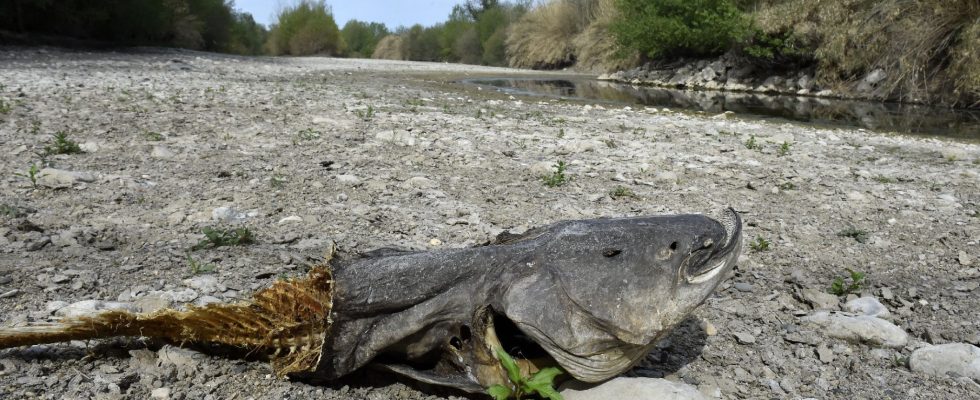“The world has just experienced its hottest start to June on record, after a month of May very close – just 0.1°C – to the temperature record set”, recently reported scientists from the Copernicus service on climate change (C3S). Will the thermometer also panic during the summer, causing strong tensions on water resources? L’Express reviews three possible black scenarios: the first on the water supply of small towns, the second on the excessive heating of rivers and the last on the drying up of crops.
Part 1 >> Drinking water: these villages preparing for the worst
The Loire and the Garonne at their lowest, the Gorges du Verdon barely passable for tourist activities… the summer of 2022 made an impression. Rarely have our waterways been so affected by drought. Will this scenario repeat itself this summer? It is still too early to say, since it is at the end of the season that the rivers stick out their tongues the most, recalls the public water information service, Eaufrance.
“Although the situation has improved in areas that have benefited from favorable rainfall, such as Brittany, the Great East or along the Channel, it has deteriorated around the Mediterranean as well as upstream of the Garonne and the Loire”, specifies the organization in a bulletin dated June 16. And the basic trend observed in recent years hardly encourages optimism. Over the period 2012-2021, across France, scientists are observing more and more drying out (temporary drying out) between the months of May and September. And even if the great rivers maintain a certain flow, it is reduced. The case of the Rhône is emblematic: between 1960 and 2020, its lowest average level decreased by 7% at the outlet of Lake Geneva and by 13% at Beaucaire (Gard), according to a study carried out by the agency Rhône-Mediterranean-Corsica water. In question: the increase in air and water temperatures, the decrease in the amount of snow on the massifs and the drying out of the soil. Over the next thirty years, the flows could be further reduced, in summer, by 20% north of the Camargue, warn the authors of the document.
This trend reduction is accompanied by a deterioration in water quality in certain areas, scientists are already warning. “In summer, we already see many practically dry rivers for which the impact is undoubtedly already strong”, recently reported to L’Express Jean-Marie Mouchel, teacher of water sciences at Sorbonne University. The phenomenon is easy to understand: since there is less water in the rivers but the quantity of pollutants does not decrease, their concentration increases. This is particularly the case for certain products used by farmers. “In forty years in France, we have had to close 25% of drinking water collection points, in particular due to nitrate and pesticide pollution”, warns hydrogeologist Florence Habets. Good quality sites are becoming rare, laments the scientist. Even groundwater is affected.
Biodiversity on the front line
But it is undoubtedly on biodiversity that global warming is wreaking the most havoc. Interviewed several times on the subject, researcher Martin Daufresne, ecologist at the National Institute for Research in Science and Technology for the Environment and Agriculture (Irstea), made his calculations: during the 2003 heat wave, the water from the Saône remained at more than 25°C for seventy-five days, between June and August. Result: the number of molluscs has been halved. Some species have even disappeared. And despite more favorable seasons thereafter, the ecosystem never regained its initial abundance. When the temperature of rivers approaches 30°C, aquatic species begin to resist. The balance within the ecosystems is broken. The size of the individuals who survive is reduced, warns the specialist.
In this already dark panorama, nuclear power plants add an additional constraint by pumping water into rivers to cool their reactors, before rejecting it, thus creating hotter zones. This evacuation, which is subject to regulations in order to protect aquatic species, leads to “a rise in temperature between the upstream and the downstream from a few tenths of a degree to several degrees”, specifies the Authority of nuclear safety on its website. For the time being, the impact of this practice on biodiversity seems negligible on a national scale. But, as the rivers warm up, discharge standards will undoubtedly become more permissive, in order to disrupt electricity production as little as possible. Some power plants have already obtained exemptions during heat waves, allowing them to deviate from environmental standards. Too much heat stroke for some river organisms? Impossible to say. “In the event of a major risk on the network, the supply of French people with electricity remains the intangible priority, notes Vincent Lucchese in his book A France without water (ed. Alisio). Opposite, the threat of aggravating the decay of ecosystems does not weigh very heavily.
